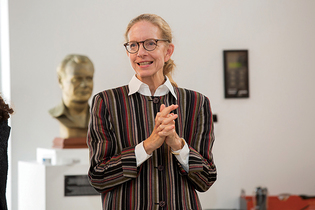
University of Miami College of Architecture
Elizabeth Plater-Zyberk
Architect
By Mark Alden Branch ’86
Elizabeth Plater-Zyberk ’74MArch came of age in architecture at just the right time. The Frank Lloyd Wright ideal of the architect as a lone genius creating original works was coming into question, and at places like Yale, says Plater-Zyberk, “it was a very fertile time for ideas. It was the period when it was okay to start looking at history.”
Plater-Zyberk was the first woman to major in architecture as an undergraduate at Princeton. The daughter of an architect, she had grown up admiring her father’s pencil drawings of old farmhouses he was helping to renovate. “I just thought those drawings were luscious,” she says. “It never occurred to me that women didn’t do that.”
Plater-Zyberk went on to the Yale School of Architecture with her Princeton classmate and future husband and business partner, Andres Duany ’74MArch. With help from one of their mentors—art history professor Vincent Scully Jr. ’40, ’49PhD—they began to notice the early-twentieth-century neighborhoods of New Haven, with their two-family houses all facing the street with copious front porches. “It brought to our attention that there was an American urbanism,” says Plater-Zyberk.
After cofounding the noted Miami architecture firm Arquitectonica in 1977, Plater-Zyberk and Duany spun off their own firm in 1980 to concentrate on their interest in urban design. They soon made their first big splash with the design for an 80-acre Florida beach community called Seaside.
The innovation behind Seaside was not only in the town plan, a grid of streets surrounding a town square. The architects also made a set of rules to govern the design of the town’s buildings; features like porches were required, as was a consistency of scale. It was an answer to what they thought was wrong with postwar American planning: the endless winding streets of suburbia, the zoning that separated even small businesses from houses, the unsustainable land use, the dependency on the automobile.
Seaside was the first of more than 300 built projects for the firm, including a number of walkable, public transit–friendly suburban developments. More important, they helped start a movement: there are now practitioners and supporters of their ideas around the world, connected through the Congress for New Urbanism, which Plater-Zyberk and Duany cofounded with four like-minded architects in 1993.
Plater-Zyberk says her goal was “to exchange knowledge, educate, and influence policy.” Instead of developing a signature style that no one else is supposed to copy, “we wanted to put forth ideas people should adopt.”
Plater-Zyberk has devoted much of her career to education. She has taught at the University of Miami since 1988 and was dean of its architecture school from 1995 to 2013. As dean, she helped shape Miami as a school where Florida’s regional traditions are valued and where urban design is an important part of the curriculum.
Plater-Zyberk and Duany stepped back from running their firm in 2017. They continue to focus on architectural responses to problems like climate change, affordable housing, and most recently COVID-19. As a longtime educator, Plater-Zyberk is a believer in the problem-solving training that architects receive. “A well-educated architect,” she says, “is a renaissance person who can deal with almost anything you throw at them.”
 loading
loading